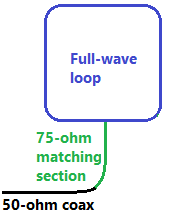Full-Wave Loop Antenna Length Calculator
Full-wave loop antennas can be large at lower frequencies, but they are quieter
than dipoles and have more gain broadside to the plane of the loop. A circular loop
is ideal, but squares, triangles, and other shapes can work well; just make the
area enclosed by the loop as big as you can.
You can use a full-wave loop on frequencies higher than design frequency as well
(for example, using a 7 MHz loop on 21 MHz), but the pattern will be different.

Full-wave loop fed with an impedance-matching transfromer made from a quarter-wave
section of 75-ohm coaxial cable
To use the calculator, enter the desired operating frequency in megahertz.
Frequency in MHz:
Length of full-wave loop:
The calculated length is approximate. In practice it's best to make the antenna
a little longer than the calculated value and then trim it to get the best SWR value.
Feedpoint impedance and coaxial matching section
The feedpoint impedance at the design frequency is about 100 ohms, so full wave
loops are often fed with an impedance-matching section made from a piece of 75-ohm
coxial cable one quarter wavelength long (shortened to compensate for the velocity
factor of the cable).
Length of an impedance-matching section with 75-ohm cable with a velocity factor of 0.66 (polyethylene dielectric):
Length of an impedance matching section made with 75-ohm cable with a cable velocity factor of 0.80 (foam dielectric):
Formulas
The formulas for calculating the approximate length of a full-wave loop antenna
are:
- Full-wave loop in feet = 1005 / frequency in MHz
- Full-wave in meters = 306 / frequency in MHz
The formulas for calculating the length of an impedance matching section are:
-
Quarter-wave matching section length in feet = 246 * cable's velocity factor / frequency
in MHz
-
Quarter-wave matching section length in meters = 75 * cable's velocity factor /
frequency in MHz
The velocity factor for polyethylene coax is usually 0.66. For foam-dielectric cable,
it's usually 0.8.
The antenna can be connected by other means, of course, including parallel-conductor
lines, which work best when using the antenna on multiple bands.
References
The ARRL Antenna Book for Radio Communications